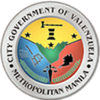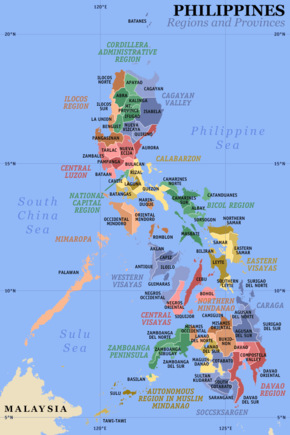Valenzuela City
| Valenzuela City Lungsod ng Valenzuela |
|||
|---|---|---|---|
| — City — | |||
|
|||
| Nickname(s): The Vibrant City | |||
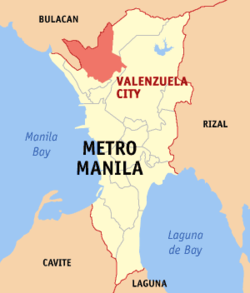 |
|||
 Valenzuela City
|
|||
| Coordinates: | |||
| Country | Philippines | ||
| Region | National Capital Region | ||
| District | 1st and 2nd districts of Valenzuela City | ||
| Barangays | 32 | ||
| Incorporated (barrio) | 16th century | ||
| Incorporated (town) | 1632 | ||
| Incorporated (city) | February 14, 1998[1] | ||
| Government | |||
| - Mayor | Sherwin T. Gatchalian (NPC) | ||
| - Vice-Mayor | Eric M. Martinez (Liberal) | ||
| Area | |||
| - Total | 44.59 km2 (17.2 sq mi) | ||
| Population (2007) | |||
| - Total | 568,928 | ||
| - Density | 12,759.1/km2 (33,045.9/sq mi) | ||
| Time zone | PST (UTC+8) | ||
| ZIP code | 1440 (Valenzuela City Post Office), others: see below | ||
| Area code | 02 | ||
| Website | www.valenzuela.gov.ph | ||
The City of Valenzuela (Filipino: Lungsod ng Valenzuela) is a highly-urbanized, first-class city [2] and one of cities in the Philippines that constitutes Metro Manila. The city has 568,928 residents as of August 2007 and is primarily an industrial and residential suburb of Manila.[3] The North Luzon Expressway passes through the city and out of Metro Manila into the province of Bulacan.
Valenzuela has a land area of 44.59 km2 divided into several domain: residential, industrial and cultural. It is bordered by Meycauayan City, Quezon City and northern Caloocan City to the east; by Obando in Bulacan to the west; by Malabon City, southern Caloocan City and Tullahan River to the south.
Since becoming a city in 1998, Valenzuela’s economy has flourished and its population has swelled significantly.[4]
Contents |
Etymology
Valenzuela, in Spanish language, is a diminutive form of Valencia, Spain. Valenzuela means little Valencia.[5] The name Valenzuela is also the surname of Pío Valenzuela, a Filipino physician and patriot who was among the leaders of the Katipunan. It may be remembered that Valenzuela was one of the triumvirate of the Katipunan that started the Philippine Revolution against Spanish colonial authorities.[6]
Originally, Valenzuela was called Polo. The name Polo was derived from the Tagalog term pulô meaning island, though the area was not an entirely island for itself. The original town of Polo was blessed by the rivers from the north and Tullahan River on the south, one of the branching rivulets of the Pasig river system of Metro Manila. Hence, the enclosed land was thought to be an island, so the early town men regarded the place as Pulo which later evolved into Polo done by hispanicization of the word.
Today, the term Polo only applies to the barangay of Polo, the birthplace of Dr. Pio Valenzuela himself, which is found in the city's first congressional district.
History
During its long history, the city played an important role in the development of northern Metro Manila. Before its cityhood on 1998, the city was divided economically into a Spanish friar hacienda, small political settlement and a Spanish garrison before the Philippine Independence in 1898. Valenzuela City was once part of the Bulacan province. In 19th century, its huge land area was subdivided into Polo, Novaliches, Obando, and others merged into the province of Morong. Later on in the American period, the city became part of Bulacan and colonial government commissioned the construction of Marcelo H. del Pilar Expressway. The expressway later became North Luzon Expressway during Marcos's era.
The liberation of the Philippines from Japanese rule on 1946 resulted in the division of Valenzuela into two towns.
On 1960, President Diosdado Macapagal signed a bill creating the municipality of Valenzuela independent from Bulacan. However, on 1963, the bill was reverted, making the northern Polo under Bulacan again, while the southern Valenzuela town became an independent municipality. The creation of Metro Manila Commission and National Capital Region during Marcos' administration led to unification of Polo and Valenzuela into a municipality of Valenzuela in 1975. Valenzuela finally attained cityhood status on February 14, 1998.
Spanish colonization
| Evolution of area of Valenzuela City | ||||||||||||||||||||||||||||||||||||||||||||||||||||||||||||||||||||||||||||||||||||||||||||||||||||||||||||||||||||||||||||||||||||||||||||||||||||||||||||||||||||||||||||||||||||||||||||||||||||||||||||||||||||||||||||||||||||||||||||||||||||||||||||||||||||||||||||||||||||||||||||||||||||||||||||||||||||||||||||||||||||||||||||||||||||||||||||||||||||||
|---|---|---|---|---|---|---|---|---|---|---|---|---|---|---|---|---|---|---|---|---|---|---|---|---|---|---|---|---|---|---|---|---|---|---|---|---|---|---|---|---|---|---|---|---|---|---|---|---|---|---|---|---|---|---|---|---|---|---|---|---|---|---|---|---|---|---|---|---|---|---|---|---|---|---|---|---|---|---|---|---|---|---|---|---|---|---|---|---|---|---|---|---|---|---|---|---|---|---|---|---|---|---|---|---|---|---|---|---|---|---|---|---|---|---|---|---|---|---|---|---|---|---|---|---|---|---|---|---|---|---|---|---|---|---|---|---|---|---|---|---|---|---|---|---|---|---|---|---|---|---|---|---|---|---|---|---|---|---|---|---|---|---|---|---|---|---|---|---|---|---|---|---|---|---|---|---|---|---|---|---|---|---|---|---|---|---|---|---|---|---|---|---|---|---|---|---|---|---|---|---|---|---|---|---|---|---|---|---|---|---|---|---|---|---|---|---|---|---|---|---|---|---|---|---|---|---|---|---|---|---|---|---|---|---|---|---|---|---|---|---|---|---|---|---|---|---|---|---|---|---|---|---|---|---|---|---|---|---|---|---|---|---|---|---|---|---|---|---|---|---|---|---|---|---|---|---|---|---|---|---|---|---|---|---|---|---|---|---|---|---|---|---|---|---|---|---|---|---|---|---|---|---|---|---|---|---|---|---|---|---|---|---|---|---|---|---|---|---|---|---|---|---|---|---|---|---|---|---|---|---|---|---|---|---|---|---|---|---|---|---|---|---|---|---|---|---|---|---|---|---|---|---|---|---|---|---|---|---|
*Catanghalan was merged then to Meycauayan. Later, it was transferred to Obando.
**Novaliches was ceded to the newly-formed Quezon City (created in 1939) in 1950. |
||||||||||||||||||||||||||||||||||||||||||||||||||||||||||||||||||||||||||||||||||||||||||||||||||||||||||||||||||||||||||||||||||||||||||||||||||||||||||||||||||||||||||||||||||||||||||||||||||||||||||||||||||||||||||||||||||||||||||||||||||||||||||||||||||||||||||||||||||||||||||||||||||||||||||||||||||||||||||||||||||||||||||||||||||||||||||||||||||||||
The history of Valenzuela is incomplete unless the history of its mother province, Bulacan, is included. For hundreds of years, present-day Valenzuela, Obando and Novaliches (now in Quezon City) were parts of Bulacan. Therefore, the history of Bulacan before 1623 was also the history of Valenzuela.
Province of Bulacan
When Spanish conquistadores reached Luzon island and established a settlement in Manila,[7] they found Bulacan as a strong united community ruled by the Rajah and his princes. Until today, the etymology of Bulacan is unclear, although many historians believe that the word bulacan came from any of the following:
1. The vast area of the region was entirely covered by green pastures, mountains, and forests. It was also full of fruit trees, vegetables, and flower orchards. The natives there called such a place bulak-lakan, meaning flower farm in Tagalog. It was Hispanized to bulakan, and finally, to bulacan.
2. Taking the Tagalog root word of bulacan, bulac, which in modern orthography becomes bulak or cotton. The region is also plenty of cotton trees in the north, and in fact, it is a major industry there.
Early Hispanic history of the region
The area encompassed by the present-day Valenzuela City, Novaliches, and Obando municipality and portions of land in southern Caloocan City were formerly known during Spanish period as Polo. The region, is significantly bounded by the Tullahan River on the south and streams of branching Río Grande de Pampanga on some areas.
According to Philippine historians Emma Helen Blair and James Alexander Robertson, there existed an infamous Battle of Bangkusay in Bangkusay Channel, Tondo headed by Maynila king Rajah Sulayman, which employed seafarers and warriors from all over parts of the north of Maynila Kingdom and Bulacan.[8] The battle was declared against Spanish conquering forces of Miguel López de Legazpi on June 3, 1571. Spanish troops were headed by Legazpi's nephew, Martín de Goiti. On June 3, 1571, Sulayman led his troops and attacked the Spaniards in a decisive battle at the town of Bangkusay, but they were defeated, and Sulayman himself was killed.[8] With the destruction of Sulayman's army and the friendship with Rajah Lakandula, the Spaniards were enabled to establish throughout the city and its neighboring towns.[9]
Legazpi formally established settlement on Maynila on June 24, 1571.[8] According to Father Martinez de Zuñiga, a Spanish missionary of Augustinian order, Maynila was a vast region enclosed by the towns of Polo, Tambobong (now Malabon City), and mountains of San Mateo in Morong. The region of Valenzuela, was formally merged under the rule of Bulacan town of Catanghalan.[8]
On 1587, the Tagalog cabeza de barangay of Catanghalan Tassi Bassi joined the Tondo chieftain Magat Salamat's planned insurrection against Spanish colonization of Maynila.[10] The rebellion was composed of kin-related noblemen or maharlikas of Maynila including Juan Banal, another Tondo chief and Salamat’s brother-in-law; Gerónimo Basi and Gabriel Tuambacar, brothers of Agustín de Legazpi; Pedro Balinguit, the chief of Pandacan; Felipe Salonga, the chief of Polo; Dionisio Capolo (Kapulong), the chief of Candaba and brother of Felipe Salonga; Juan Basi, the chief of Taguig; Felipe Salalila, the chief of Misil; Agustin Manuguit, son of Felipe Salalila; Luis Amanicaloa, another chief of Tondo; Felipe Amarlangagui, the chief of Caranglan; Omaghicon, the chief of Navotas and Pitongatan (Pitong Gatang), another chief of Tondo. In Philippine history, this was notably known as Tondo Conspiracy of the Maharlikas, a plot of series of "revolution" against Spain that included several native noblemen. The planned revolution was never happened because whistleblowers revealed the nature of it to Spanish authorities.[11]
When Manila became an archdiocese on August 14, 1595 based upon Pope Gregory XIII's Papal order, regular friars that had already established permanent church in Catanghalan decided that the attached sitio of Polo be divided to cater spiritual needs of an increasing population all over.[12] Thus, on 1623, upon order of Governor-General Alonso Fajardo de Entenza, sitio Polo became independent from Catanghalan although the two was still under the alcaldía (Spanish title for local government during that time) of Bulacan.
Establishment of the town
Prior to the elevation of Manila as an archdiocese on 1595, regular friars staying on the town of Catanghalan asked for an appeal from Governor-General Entenza to have another separate town from former. Through successive efforts of Fray Juan Taranco and Don Juan Monsód, sitio Polo was successfully separated from Catanghalan in 1623, but still under jurisdiction of the alcaldía de Bulacán. Thus, the first cabeza de barangay of the new town of Polo was Monsód and Taranco operated the present San Diego de Alcalá parish on a small tavern.[13]
It was in the year 1627 when the construction of the Parochial church dedicated to San Diego de Alcala started. Finally, in 1629, the church was fully constructed. Its fabrication was supervised by Fr. José Valencia aided by Capitan Juan Tibay. The church was fully repaired and remodeled under the direction of Fr. Vicente in 1852. A great change took place in the appearance of the church, that according to the missionaries it was one of the best ever built in the archipelago, and became the envy among other towns. Again, the church after its repair was dedicated to another patron, the "Nuestra Senora de la Inmaculada Concepcion". Still, another dedication was made and that was to San Roque. The convent was well built and comfortable. The pride of its artistry lies on the fact that the people of the town had done so much to its perfection. Besides the convent, a descent "casa tribunal" with a rectangular prison cell was built, and a school house also fabricated of stones was erected.
During 1635, the Sangleys at Parian in Manila and in the neighboring towns staged an insurrection against the Spanish government. It was during one of these rebellions that the church bells brought by the Spanish Missionaries to the town which was made of bronze, and whose intonations were second only to that of the bell of St. Peter's Basilica in Rome, was stolen by the Chinese. Since it was so huge, the looters had to break it into small pieces in order to remove it from the belfry.
Philippine Revolution, American occupation and World War II
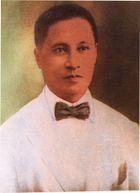
The Americans established the military rule and Dr. Pío Valenzuela was appointed first president of the town on September 6, 1899. He resigned on February 1902.
Rufino Valenzuela became the first elected president of the Town in 1904.
The entrance of the Japanese in Polo was without any resistance. The people during the Japanese time enjoyed prosperity for Polo became a market town. There were more signs of cooperation and social contact among the inhabitants but on the contrary, fear of reprisals from the Japanese predominated. The town also became a place of terror. There were too many murders committed. The place became a habitat of Makapilis, and spies who troubled the peaceful civilians. The sudden appearance of the Japanese added terror to the place.
The reign of terror climaxed on December 10, 1944. It was a day of mourning for the people of Polo and Obando for it was the day when the Japanese massacred more than a hundred males in both towns. At about 1:00am on this day up to the setting of the sun, cries could be heard from the municipal building when males who were screeded by the "Magic Eye" inside the church were being tortured to death. (This could be the reason why the old church was not anymore restored, and be neglected to ruins, thus building a new edifice beside the old one.) Mayor Ponciano met the same fate. He died a cruel death on this day with the municipal officials.
When liberation came, the town was partly burned by the approaching the military forces of the Filipinos and Americans who threw flame throwers and shelled the big houses in the town, not exempting the more than 300 years old church of San Diego.
The historical old bridge was destroyed by the Japanese, thus separating Polo in two parts, the Northern and the Southern Parts. The northern part was at once liberated by joint Filipino and American troops while the southern part, which includes the Poblacion was still under the Japanese banner. The Japanese abandoned the town on February 11, 1945 when the combined American and Filipino troops were able to cross the river and took the town.
Polo, Bulacan to Valenzuela City
On July 21, 1960, President Diosdado Macapagal signed Executive Order No. 401, which led to the creation of the separate municipalities of Valenzuela and Polo, in honor of Dr. Pío Valenzuela, a significant personality in Philippine history who was born here. The new town of Polo comprised the barangays on the northern part namely Poblacion, Palasan, Arkong Bato, Pariancillo Villa, Balangkas, Mabolo, Coloong, Malanday, Bisig, Tagalag, Rincon, Pasolo, Punturin, Bignay and Dalandanan. The new town of Valenzuela comprised the southern barangays: Karuhatan, Marulas, Malinta, Ugong, Mapulang Lupa, Canumay, Maysan, Paso de Blas, Bagbaguin and Torres Bugallon (now Gen. T. de Leon).After three years of administrating the two towns, however, the local government and their respective constituents realized that a division of Polo and Valenzuela was ill advised and only resulted in underdevelopment instead of progress. Thus, in September 11, 1963, another law, Executive Order No. 46 was signed by then President Diosdado Macapagal; this declared the re-unification of the towns of Polo and Valenzuela, which led to the adoption of the name "Valenzuela" in respect to and to perpetuate the legacy of the great patriot, Dr. Pío Valenzuela.
Because of the rapid growth of the National Capital Region in terms of population, as well as social and economic requirements in the early seventies, and the municipality's proximity to the area, During the Marcos administration, Valenzuela was taken from the province of Bulacan and was included in the created MMDA (Metro Manila Development Authority) and the NCR (National Capital Region). Presidential Decree Number 824 was issued on November 7, 1975, creating the Metropolitan Manila Commission and separating the Municipality of Valenzuela from the Province of Bulacan.
As part of the National Capital Region, the social and political upheavals of the seventies and early eighties did not dampen the pulsating economy of the municipality. It was, in fact, a golden age in the history and culture of Valenzuela when businesses and industries in the municipality grew rapidly.
The passage of the Local Government Code in 1991 unlocked and marshaled the repressed energies of local communities. The Local Government Code provides genuine and meaningful autonomy to enable local governments to attain their fullest development as self-reliant communities. It was during this time that Valenzuela began charting its own destiny and moved the local economy in the direction it chose.
From then on, Valenzuela had to cope with rapid urbanization as part of the National Capital Region. It is considered as a vital link between the National Capital Region and Northern Luzon. And 23 years after its separation from Bulacan and 375 years after its founding, On February 14, 1998, then President Fidel Ramos signed Republic Act No. 8526, converting the Municipality of Valenzuela under the administration of Mayor Bobbit L. Carlos into a highly urbanized city, making Valenzuela the 12th city in Metro Manila and the 83rd in the Philippines.[14]
Geography
Climate
| Climate data for Valenzuela City, Philippines | |||||||||||||
|---|---|---|---|---|---|---|---|---|---|---|---|---|---|
| Month | Jan | Feb | Mar | Apr | May | Jun | Jul | Aug | Sep | Oct | Nov | Dec | Year |
| Record high °C (°F) | 35 (95) |
35 (95) |
36 (97) |
37 (99) |
38 (100) |
38 (100) |
38 (100) |
36 (97) |
35 (95) |
35 (95) |
35 (95) |
34 (93) |
38 (100) |
| Average high °C (°F) | 30 (86) |
31 (88) |
32 (90) |
33 (91) |
33 (91) |
32 (90) |
31 (88) |
30 (86) |
31 (88) |
30 (86) |
30 (86) |
30 (86) |
31 (88) |
| Average low °C (°F) | 21 (70) |
22 (72) |
22 (72) |
24 (75) |
25 (77) |
25 (77) |
24 (75) |
23 (73) |
23 (73) |
23 (73) |
23 (73) |
22 (72) |
23 (73) |
| Record low °C (°F) | 14 (57) |
14 (57) |
16 (61) |
16 (61) |
17 (63) |
20 (68) |
22 (72) |
21 (70) |
21 (70) |
21 (70) |
19 (66) |
17 (63) |
14 (57) |
| Precipitation cm (inches) | 2 (0.8) |
1 (0.4) |
1 (0.4) |
3 (1.2) |
12 (4.7) |
26 (10.2) |
40 (15.7) |
36 (14.2) |
34 (13.4) |
19 (7.5) |
13 (5.1) |
6 (2.4) |
197 (77.6) |
| Source: Weatherbase[15] | |||||||||||||
Valenzuela as a gateway
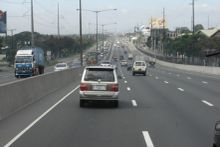
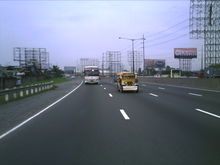
Two major highways traverse Valenzuela City — the MacArthur Highway and the North Luzon Expressway. The proximity of the North Luzon Expressway to the city center makes Valenzuela a northern gateway to Metro Manila and a choice location for business. Public transportation within the city, like in most of the urban areas in the Philippines, is facilitated mostly using inexpensive jeepneys and buses. Tricycles are used for short distances, while taxi cabs are used by the upper middle class to navigate any course.
Government and politics
Like other cities in the Philippines, Valenzuela City is governed by a Mayor and Vice Mayor who are elected to three-year terms. The Mayor is the executive head and leads the city's departments in executing the city ordinances and improving public services. The Vice Mayor heads a legislative council consisting of 15 members: 6 Councilors from the First District, 6 Councilors from the Second District, the President of the Sangguniang Kabataan (Youth Council) Federation, representing the youth sector, and the President of the Liga ng mga Barangay (SB) as barangay sectoral representative. The council is in charge of creating the city's policies in the form of Ordinances and Resolutions. The current mayor of the city is Sherwin T. Gatchalian and the Vice-Mayor is Eric M. Martinez. There is also a representative and six councillors for each of the two districts.
Institutions
The city government has various units that cater the needs of their people.[16] They are:
|
|
Himig Valenzuela
Himig Valenzuela, or Valenzuela Hymn, is the official city song of the city [17][18]. It is sung during flag ceremonies of private, public and government institutions along with the Philippine national anthem, Lupang Hinirang.
Districts and barangays
Barangays
Valenzuela is composed of 32 barangays which are grouped into two congressional districts, and two legislative districts. Legislative District one contains 23 barangays in the northern half of the city, while legislative District two occupies the 9 barangays in the southern portion of the city.
|
District 1
|
District 2
|
Largest barangay hall
Philippine president Gloria Macapagal-Arroyo, assisted by Valenzuela mayor Sherwin Gatchalian, barangay Maysan chairman Enrique Urrutia, on May 15, 2008, inaugurated the largest P 27 million (3-storey building with a floor area of 3,000 square meters on a 936-square-meter lot) barangay hall in the Philippines. The Maysan Barangay Complex is built in the middle of the 253-hectare barangay Maysan, Valenzuela City.[19]
Demography
| Population Census | |||
|---|---|---|---|
| Census | Pop. | Rate | |
| 1948 | 16,740 |
|
|
| 1960 | 41,473 | 7.9% | |
| 1970 | 98,056 | 9.0% | |
| 1975 | 150,605 | 9.0% | |
| 1980 | 212,363 | 7.1% | |
| 1990 | 339,609 | 4.8% | |
| 1995 | 437,165 | 5.2% | |
| 2000 | 485,433 | 2.27% | |
| 2007 | 568,928 | 2.21% | |
| Source: Valenzuela City population National Statistics Office |
|||
As of the 2000 census of population, Valenzuela City has 485,433 people residing in 106,382 residential households, and the average household size was 4.56 persons.[20] On 2007 census count, the city has a general population density of 12,759.1/km2. From 1990–1995, population growth rate was 2.54% and is expected to double the 2000 population by 2026. The city contributes 4.89% to the population of Metro Manila, thus making it 5th in the region; and gives 0.63% to the whole country. Of the 32 barangays making up the city, barangay Gen. T. de Leon is the most populous barangay (as of 2007) of 95,536 person with density of 260.39 per km2 making 16.79% of the city's population, followed by barangay Marulas with 9.23% (density 251.24 per km2) and barangay Malinta with 7.69% (density 251.41 per km2).[21][22]
The city's population spread out to 0–14 years old by 32.74% and 2.39% for the 65 years old and above group. The economically active people, 15–64 years group, is 64.87% of the city. In general, half of the population is below 23 years old. General dependency ratio in 2000 is 54.16%, which means that there are 54 individuals from 0-14 and 65 and above age groups that are independent to every 100 individuals from the 15-64 group. Males outnumbered females by a ratio of 101.37 for every 100 females.[21][22]
Males dominated the age group of 0-14 and 25–54 years old while females exceeds the number of females to the rest of age groups. There are 2.03 children born to every ever-married women in the city. About 57.38% of the female population are in the 15–49 years reproductive group, with 11.71% are in the 20-24 age group. Females on the 15–19 years group may bear an average of 0.66 person; the 20–24 years may bear an average of 0.96 person; 25–29 years groups may bear an average of 1.52 person/s; 30-34 may bear 2.12 persons; 35-39 may bear 2.58 persons; 40-44 may bear 2.71 persons; and 45-49 may bear 2.82 persons.[21][22]
As of 2000 census, females dominated the population in terms of education: 50.04% were college undergraduates, 54.23% were academic degree holders and 56.27% finished post-baccalaureate studies. In 2000, 2.09% of the population held pre-school education as the highest educational attainment (51.81% male, 48.19% female), 27.68% were elementary (49.92% male, 50.08% female), 37.35% were secondary (50.63% male, 49,37% female), 4.62% were post-secondary (50.14% male, 49.86% female), 19.64% were undergraduate/academic degree/post-baccalaureate holders or combination of them (48.99% male, 51.01% female) and 2.46% never attended school at all (52.42% male, 47.58% female).[21][22]
As of 2000 census, the city was composed of 71.92% Tagalogs (71.78% male, 28.22% female), 4.55% Bicolanos (51.78% male, 48.22% female), 4.32% Bisayas (50.07% male, 49.93% female), and 15.99% are of other ethnicity (50.41% male, 49.59% female). On the other hand, 0.02% are of foreign ethnicity (68.37% male, 31.63% female).[21][22]
Education
The city government prides itself in giving free education to its quality free education to its constituents through its primary, secondary and tertiary schools.
Valenzuela City has many colleges and universities, like the city-owned Pamantasan ng Lungsod ng Valenzuela and Valenzuela City Polytechnic College. There are also privately-owned academic institutions include the Our Lady of Fatima University, one of the most prestigious universities in the Philippines that produces a great number of board topnotchers in the field of medicine.[23][24][25][26]
Infrastructure
Healthcare
Valenzuela City provides medical missions and free medical operations in the city. Fully-functional health facilities serves in every barangay.
Currently, the Mayor WIN Mobile Health Clinic go around the city to provide general medical procedures and dental services.[27][28] Also conducted are laboratory services including ECG, FBS, Cholesterol, Triglycerides, Urinalysis, CBC, platelet count and pregnancy test.[28] A Mobile Pharmacy is, likewise, deployed to distribute free medicines ranging from kids and adult vitamins to fever, cough and flu medicines, antibiotics, de-worming tablets, among others.[27]
There are numerous hospitals in Valenzuela City , like the city-run Valenzuela City Emergency Hospital & Valenzuela City General Hospital, which is under the national government.[29] There are also privately owned hospitals like Calalang General Hospital, Sanctissimo Rosario General Hospital and Fatima University Medical Center, a tertiary private hospital under the administration of Our Lady of Fatima University.[29][30][31][32]
VC Cares program
A health and social welfare service delivery system which promotes self-reliance within a caring society. The VC Cares Program is designed for individuals who are unable to provide for themselves health care and basic necessities or meet special emergency situations of need.[33] While health care service and financial assistance are generally the forms of assistance given, these may be supplemented by other forms of assistance, as well as problem-solving and referral services. Appropriate referrals may be made to other agencies or institutions where complementary services may be obtained.[34]
Polio immunization program
On July 12, 1976, DOH launched the Expanded Programme on Immunization (EPI) [35] which covers immunization for BCG (for extrapulmonary tuberculosis), DPT (Diphtheria, Pertussis and Tetanus), oral polio vaccine (OPV) (for poliomyelitis), Hepatitis B (for hepatitis infection), and measles (for measles infection). The DOH is assisted by local government units and government hospitals in the implementation and administration of this program. In Valenzuela, 82.5% and 75.3% were reported immunized with three doses of the same vaccine during the period, respectively.[36]
According to the 2002 Commission on Audit, the city reported accomplishment per health center ranging from as low as 42.26% to as high as 206% and vaccine utilization of 33% to 90% compared to normal 46% to 377% per basic requirements.[36] As the Polio Immunization Program is a continuing activity of the Government and deficiencies in program implementation would greatly affect the ability of the government to protect the intended coverage, the team recommended measures to address these concerns for consideration by the city of Valenzuela.
Anti-dengue programs
Since the establishment of the city, Valenzuela has been subjected to problems dealing with health. There are swampy areas on Valenzuela and there is a stagnant water in Tullahan River on the south, which make citizens vulnerable to mosquito-linked diseases such as dengue and malaria. Though malaria is not a common case in Valenzuela–the city ranks consistently among top five dengue-infected regions in the Philippines with around 560% chance of recurrence every year.[37][38] In the second quarter of 2008, however, only 500% increase was reported compared to the same period in 2007.[39]
To address this concern, Valenzuela mayor Sherwin Gatchalian reorganized the city's Anti-Dengue Task Force (ADTF).[40] The task force is headed by Gatchalian, as the chairperson with the city health officials and workers as members. ADTF was tasked to, primarily, disseminate information drives on how to prevent and clean mosquito-breeding sites, cleanliness campaign against dengue, and house-to-house inspection.[41] At areas with serious dengue infection, regular fogging and larvae-trapping are applied.[42] According to Health secretary Francisco Duque III, even though the city has high infection rate to dengue, it only have very low fatality rate.[40]
In September 2009, the Department of Health distributed free Olyset anti-dengue nets treated permethrin insecticide to Gen. T. de Leon High School. Over 150 rolls of the nets were given and installed to the windows of the said school, as part of DOH's "Dalaw sa Barangay: Aksyon Kontra Dengue" (Visit Barangay: Action against Dengue) campaign.[43]
Shopping centers and utilities
On October 28, 2005 SM Supercenter Valenzuela was inaugurated.[44] Other shopping sites such as Puregold Valenzuela, and the newly renovated South Supermarket.[45][46] All these stores compete against each other since most have the same product offerings as diversified groceries. People from the city with more major shopping needs normally head south to cities such as Quezon City and Manila, since they have bigger malls and commercial centers with more diverse trade goods.
Valenzuela's source of electricity is part of the Manila Electric Company or Meralco. Water supply for the city is supplied by the Maynilad Water. Valenzuela's communication system is powered by the Philippine Long Distance Telephone Company, Globe Telecom, Bayan Telecommunications Corporation (BayanTel) and others. Cellular network in the Philippines particularly the metropolitan areas is increasing rapidly together with the low cost of calls and text messaging. Such big companies that control the cellular networks in the Philippines and Valenzuela itself are Globe Telecom, Smart Communications (PLDT) and Sun Cellular from Digitel. Cable television access is provided by SkyCable, Home Cable and Global Destiny. Internet Digital Subscriber Line or DSL coverage is provided by PLDT, cable internet is serviced by Sky Cable's ZPDee and Global Destiny. Wireless broadband is provided by Globeliness Broadband and Smart Communications.
Banking
Almost all of the major commercial banks in the Philippines operate a branch in the city. Major banks operate more than one branch in the city, and at this time, there are 50 banking institutions offer banking services to businesses and residents. Most of these are concentrated in Barangay Karuhatan, Gen. T. De Leon, Marulas and Malinta. A new row of banks are located near the Paso de Blas road by the entrance of the North Expressway's Malinta Exit.
Waste management
According to the 2002 Metro Manila Solid Waste Management Report of the Asian Development Bank, Valenzuela has the highest number of identified recycling companies in the region.[47] It was also said that recycling centers related to plastic materials are relatively higher than other recyclable objects like metals, paper, glass among others.[47] Accordingly, the city government allocates an amount of about PhP 785.70 for every transportation and collection costs of a ton of waste material.[48] In 2003, the city generated about 307.70 tons of waste every day.[48]
In 1988, the city opened its first waste disposal facility, the Lingunan Controlled Dumpsite. Every year, the facility collects and processed only about 60% of the entire city's waste.
Landmarks and attractions
Locations
- Residence of Dr. Pío Valenzuela - Dr. Pío Valenzuela was part of the triumvirate, along with Andrés Bonifacio and Emilio Jacinto, that composed the Katipunan, and was one of the founders of Ang Kalayaan — the official organ of the movement. He was born on July 11, 1869 in this house along Velilla Street in Barangay Pariancillo Villa.
- Bell Tower of San Diego De Alcala Church - The Church of San Diego de Alcala was built in 1632 by the people of Polo. Residents were taken to forced labor to complete the church after the town gained its independence through Father Juan Taranco and Don Juan Monsod. The belfry and entrance arch, which are over four centuries old, are the only parts of the edifice that remain to this day. The main structure was destroyed by bombs during the Japanese occupation. Residents of Barangays Polo and Poblacion celebrate the Feast Day of San Diego de Alcala on the 12th of November every year.[49]
- Arkong Bato - Literally, Arkong Bato is an arch of stone along M.H Del Pilar Street, built by the Americans in 1910. The arch then marked the boundary between the provinces of Rizal and Bulacan.In the olden days, M.H Del Pilar was the primary road leading to Northern Luzon before MacArthur Highway and North Luzon Expressway was opened. After Malabon and Navotas seceded from Rizal to become independent municipalities, the Arch now marked the boundary between Barangay Santulan in Malabon and Barangay Arkong Bato in Valenzuela.
- Museo ng Valenzuela -To date, it is in the 3rd phase of construction. The original museum of Valenzuela was the house where Dr. Pío Valenzuela, a hero in the struggle of freedom against Spain and in whose memory the old town of Polo was renamed, was born and saw the best years of his life. This same house was burned recently. Valenzuela City's historical and cultural landmark, Museo Valenzuela features collections of artifacts depicting the city's past and continuing development. Special focus is given on the life and times of one of its illustrious sons, Dr. Pío Valenzuela, after whom the city was named in 1963. The Museo serves as a repository of Valenzuela's rich heritage and a beacon of light to its people and guests. It is likewise a venue for historical, cultural, and artistic presentations as well as seminars and symposia on national and local issues.
- National Shrine of Our Lady of Fatima -The National Shrine of Our Lady of Fatima, the center of the Fatima apostolate in the country, was declared a tourist site in 1982 by the Department of Tourism and a pilgrimage shrine this year by the Diocese of Malolos. It is near the Our Lady of Fatima University.[50]
- Valenzuela City Convention Center -This is the center of performing arts of Valenzuela . This facility also caters to various events such as plays, concerts, shows, exhibits and seminars.
- Valenzuela City Hall-The city hall surrounding many city government agencies and offices, and open areas, and it was located in the heart of the city. It was built in 1967
- Valenzuela City Government Center-A One stop shop. Faster, more convenient service. Bigger, more comfortable taxpayer’s lounge. Located on a 2,227.5sq. meters lot along MacArthur Highway, the three-storey building will house all revenue-generating offices such as the City Treasury and the Business Permits and Licensing Office (BPLO) The new taxpayers lounge will not have drawers and tables inside the offices.
Feasts
| Valenzuela traditional feasts | |||
|---|---|---|---|
| Name | Date | Location | |
| Sta. Cruz Festival | April 26 | Barangay Isla | The Santacruzan was a novena procession commemorating St. Helena's mythical finding of the cross. St. Helena was the mother of Constantine the Great. According to legends, 300 years after the death of Christ, at the age of 75, she went to Calvary to conduct a search for the Cross. After some archeological diggings at the site of the Crucifixion, she unearthed three crosses. She tested each one by making a sick servant lie on all three. The cross where the servant recovered was identified as Christ's. St. Helena's feast day falls on August 8 but the anniversary of the finding of the Cross is on May 3, in the Philippines, this celebration took the form of the Mexican Santa Cruz de Mayo.[51] |
| Mano Po San Roque Festival | May 12 | Barangay Mabolo | In Valenzuela, San Roque is also known as the patron saint of the unmarried. It’s the day for single women to ask for help in finding their true love. There are countless tales of single girls who danced and prayed in the procession and who claim to have found their husband during the fiesta. Street dancing and procession along the city’s major thoroughfares in commemoration of the feast of San Roque, highlighting the customs and traditional celebration of the festival.[52][53] |
| Feast of San Diego De Alcala | November 12 | Barangay Poblacion | Celebration of the feast of the oldest church in Valenzuela City, which includes annual boat racing, street dancing and different fabulous activities of the festival.[54] |
| Putong Polo Festival | November 12 | Barangay Polo | As part of the San Diego de Alcala Feast Day, it is one of the unique food festival in the country which features the famous putong Polo, the small but classy “kaka in” which was originally created in the town of Polo, Valenzuela.[49][55] |
Zip codes
The Philippine Postal Corporation, to ease their mailing services throughout the city, adopted the use of ZIP codes. There are several ZIP codes applicable to Valenzuela City which divides the area into several numbers starting at 14, except for special cases that receive and send huge volumes of mail:
|
Big users
|
Sister cities
 Bucheon, South Korea
Bucheon, South Korea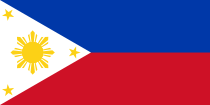 Sta. Cruz, Marinduque
Sta. Cruz, Marinduque
See also
- Legislative districts of Valenzuela City
Citations
- ↑ The Valenzuela City Charter Retrieved July 28, 2009
- ↑ "Local Government and Taxes:Cities and their income classification (1993, 1995, 1997, 2001, 2005)". Democracy and Governance in the Philippines. http://www.newsbreak.com.ph/democracyandgovernance/Income_Classification_and_List_of_Cities.html. Retrieved 2009-05-12.
- ↑ "Municipality/City: City of Valenzuela". National Statistical Coordination Board. http://www.nscb.gov.ph/activestats/psgc/municipality.asp?muncode=137504000®code=13&provcode=75. Retrieved 2009-09-19.
- ↑ Valenzuela City Public Information Office
- ↑ Dictionary of American Family Names, Oxford University Press, ISBN 0-19-508137-4
- ↑ "Dr. Pio Valenzuela, 1869–1956". http://valenzuelausa.org/piovalenzuela.aspx. Retrieved 2009-09-21.
- ↑ See history of Manila.
- ↑ 8.0 8.1 8.2 8.3 Blair and Robertson, The Philippine Islands, 1493–1898, Vol. VIII, p. 96-141. The Arthur H. Clarke Company.; Census of the Philippines, 1903 Vol. I, p.421-423
- ↑ de Goiti, Martin (1572). "Act of Taking Possession of Luzon". http://www.filipiniana.net/ArtifactView.do?artifactID=BR2000000027&query=null&page=105. Retrieved 10 February 2009
- ↑ Zaide, Sonia; Gregorio F. Zaide (1994). The Philippines: A Unique Nation. Quezon City: All-Nations Publishing, Co., Inc.. pp. 78–79.
- ↑ Ibid., pp. 181–182. Tassi Bassi was also known as Esteban Taés.
- ↑ Ilius fulti praesido, Pope Gregory III (b. 1502-d. 1585, reigned 1572–1585) Papal Bull
- ↑ Arenas, Mar DJ (1997). Valenzuela: Ang Bayani at ang Bayan. Valenzuela: Museo Valenzuela Foundation, Inc. & Valenzuela Historical and Cultural Society
- ↑ National Library of the Philippines Archives
- ↑ "Weatherbase: Historical Weather for Philippines". Weatherbase. 2008. http://www.weatherbase.com/weather/weather.php3?s=090527&refer=. Retrieved 2009-04-22.
- ↑ "Valenzuela City–Services". http://www.valenzuela.gov.ph/services.php. Retrieved 2009-04-21.
- ↑ Republic Act No. 7160, Sec. 22 (a-3):
Section 22. Corporate Powers. - (a) Every local government unit, as a corporation, shall have the following powers: ... (3) To have and use a corporate seal; ...
- ↑ "Republic Act 7160, otherwise known as the Local Government Code of 1991 (Philippines)". http://www.lawphil.net/statutes/repacts/ra1991/ra_7160_1991.html. Retrieved 2009-05-07.
- ↑ "PGMA inaugurates RP's 'largest' barangay hall". Philippine Information Agency. May 16, 2008. http://www.pia.gov.ph/default.asp?m=12&fi=p080516.htm&no=78. Retrieved 2009-05-12.
- ↑ 2007 Census count
- ↑ 21.0 21.1 21.2 21.3 21.4 "Valenzual City: Annual population growth rate down to 2.27 percent". National Statistical Office. 9 October 2002. http://www.census.gov.ph/data/pressrelease/2002/pr02172tx.html. Retrieved 2009-09-19.
- ↑ 22.0 22.1 22.2 22.3 22.4 "National Capital region: close to 10 million persons". National Statistical Office. 14 January 2003. http://www.census.gov.ph/data/pressrelease/2003/pr0312tx.html. Retrieved 2009-09-19.
- ↑ "Our Lady of Fatima University". http://www.fatima.edu.ph/contact_us.asp#valenzuela. Retrieved 2009-05-05.
- ↑ "Pro Pinoy (2009 Licensure Examination for Nurses)". February 24, 2009. http://propinoy.blogspot.com/2009/02/2009-nursing-board-examination-top.html. Retrieved 2009-05-05.
- ↑ Gen DR, Oks! News from the Philippines (February 18, 2009). "Top 10 Physicians in 2009 (Board Exam Results)". http://oks.ph/career/top-10-physicians-in-2009-board-exam-results/. Retrieved 2009-05-05.
- ↑ "List of private schools in Valenzuela City". http://www.valenzuela.deped.gov.ph/dcsprivateschools.htm. Retrieved 2009-05-05.
- ↑ 27.0 27.1 Caiña, Zyan (October 19, 2008). "Mayor WIN Mobile Clinic Goes to Mapulang Lupa". Valenzuela Public Information Office. http://www.valenzuela.gov.ph/press.php?id=200810005&tbl=press. Retrieved 2009-05-05.
- ↑ 28.0 28.1 Caiña, Zyan (July 27, 2008). "Mayor WIN Mobile Clinic Goes to Gen. T. de Leon". Valenzuela Public Information Office. http://www.valenzuela.gov.ph/press.php?id=20080717&tbl=press. Retrieved 2009-05-05.
- ↑ 29.0 29.1 "WikiPilipinas: Hospitals in Valenzuela City (Directory)". http://en.wikipilipinas.org/index.php?title=Directory:_Hospitals_in_Valenzuela_City. Retrieved 2009-05-05.
- ↑ "Fatima University College of Medicine". http://www.fatima.edu.ph/college_medicine.htm. Retrieved 2009-05-05.
- ↑ "Sanctissimo Rosario General Hospital (business site)". http://www.philippinecompanies.com/companyprofile.php?id=26666. Retrieved 2009-05-05.
- ↑ "Calalang General Hospital's location map". http://www.calalanggenhospital.com/images/locationmap.pdf. Retrieved 2009-05-05.
- ↑ "Special Services-VC Cares Program". http://www.valenzuela.gov.ph/services1.php?id=825005&tbl=service&ofc=SPO. Retrieved 2009-05-05.
- ↑ "VC Cares conducts feeding program for children in depressed areas". July 26, 2007. pp. 3. http://www.valenzuela.gov.ph/press/PR072607.html. Retrieved 2009-05-05.
- ↑ "Expanded Program on Immunization". http://www.doh.gov.ph/programs/epi. Retrieved 2009-05-12.
- ↑ 36.0 36.1 "Sectoral Performance Audit Report on the Polio Immunization Program of the City of Valenzuela (CYs 2001–2002)". Commission on Audit. 2002. http://www.coa.gov.ph/GWSPA/2001-2002/PIP/Valenzuela_PIP01-02.htm. Retrieved 2009-05-12.
- ↑ Ortiz, Margaux (6 September 2006). "Metro records highest dengue incidence -- DoH". Inquirer.net. http://www.inquirer.net/specialfeatures/denguealert/view.php?db=1&article=20060908-19900. Retrieved 2009-09-19.
- ↑ "DOH lauds Manila for low dengue rates". Media Bureau. August 4, 2008. http://www.manilacityph.com/newsaugust.html. Retrieved 2009-09-19.
- ↑ "DOH chief visits Valenzuela amid rise in dengue cases there" (in Tagalog). GMA News,tv. 23 July 2008. http://www.gmanews.tv/video/26106/DOH-chief-visits-Valenzuela-amid-rise-in-dengue-cases-there. Retrieved 2009-09-19., in video.
- ↑ 40.0 40.1 Jehan, Torda (22 July 2008). "Declining Dengue Cases in Valenzuela City". Valenzuela Public Information Office. http://www.valenzuela.gov.ph/press.php?id=20080711&tbl=press. Retrieved 2009-09-19.
- ↑ Jehan, Torda (24 July 2008). "Sec. Duque Visits the Anti — Dengue Task Force of Valenzuela City". Valenzuela Public Information Office. http://www.valenzuela.gov.ph/press.php?id=20080715&tbl=press. Retrieved 2009-09-19.
- ↑ Caiña, Zehan (August 27, 2008). "Valenzuela City intensifies Anti-Dengue Campaign". Valenzuela Publci Information Office. http://www.valenzuela.gov.ph/press.php?id=20080819&tbl=press. Retrieved 2009-09-19.
- ↑ Caiña, Zyan (16 September 2009). "Gen. T. De Leon National High School Receives IT Nets from DOH". Valenzuela Public Information Office. http://www.valenzuela.gov.ph/press.php?id=200900559&tbl=press. Retrieved 2009-09-19.
- ↑ "Mall List-SM Valenzuela". http://www.smprime.com/smprime/index.php?p=671&mall=4. Retrieved 2009-05-07.
- ↑ "Puregold Valenzuela location map". http://wikimapia.org/582277/Pure-Gold-Valenzuela. Retrieved 2009-05-07.
- ↑ "EYP.PH List of malls in Metro Manila". http://www.eyp.ph/search?catid=19346&channel=shop&loc=Metro+Manila&locid=11488&page=1&q=Supermarkets&start=S. Retrieved 2009-05-07.
- ↑ 47.0 47.1 "Metro Manila Solid Waste Management (Part 5)". Asian Development Bank. 2002. http://www.adb.org/Documents/Reports/Consultant/35164-PHI/part05.pdf. Retrieved 19 December 2009.
- ↑ 49.0 49.1 Caiña, Zyan (November 12, 2008). "Pistang Polo 2008". Valenzuela Public Information Office. http://www.valenzuela.gov.ph/press.php?id=200810013&tbl=press. Retrieved 2009-05-07.
- ↑ Darang, Josephine (May 6, 2007). "Purely Personal : Catholics mark 90th Fatima anniversary". Philippine Daily Inquirer. http://services.inquirer.net/print/print.php?article_id=64298. Retrieved 2009-05-07.
- ↑ "Valenzuela Travel guide, Philippines". Travel Grove. http://www.travelgrove.com/travel-guides/Philippines/Valenzuela.html. Retrieved 2009-05-12.
- ↑ Vanzi, Sol Jose (May 2, 2000). "Valenzuela San Roque Festival starts tomorrow". Headlines News Philippines. http://www.newsflash.org/2000/05/tl/tl001059.htm. Retrieved 2009-05-12.
- ↑ –, Sidney (May 13, 2006). "Feast of San Roque, Mabolo, Valenzuela City". http://www.pinoytravelblog.com/travel-destinations/271/feast-of-san-roque-barangay-mabolo-valenzela-city-metro-manila. Retrieved 2009-05-12.
- ↑ "Paraiso Philippines>>Valenzuela City". http://www.paraisophilippines.com/category/metro-manila/valenzuela-city/. Retrieved 2009-05-12.
- ↑ "Special: Kulinarya Program". WOW! Philippines. http://www.tourism.gov.ph/Special/kul_event4.asp. Retrieved 2009-05-12.
References
| Wikipedia has pages related to Valenzuela City under the category of |
- Arenas, Mar DJ (1997). Valenzuela: Ang Bayani at ang Bayan. Valenzuela: Museo Valenzuela Foundation, Inc. & Valenzuela Historical and Cultural Society
- Zaide, Sonia; Zaide, Gregorio (1994). The Philippines: A Unique Nation (2nd ed.). Quezon City: All-Nations Publishing Co., Inc.
- "Official site of Valenzuela City" (in English and Filipino). http://www.valenzuela.gov.ph/.
- "Valenzuela City–Philippine Research Guide". http://www.123exp-geography.com/t/18624214345/.
- "NCR Local Officials". http://www.dilg.gov.ph/NCR/local%20officials/valenzuela.html.
- "Valenzuela City Guide". http://www.expatforum.com/city-guides/philippines/valenzuela-city-guide.html.
- "WOW! Philippines Explore Valenzuela City". http://www.tourism.gov.ph/explore_phil/place_details.asp?content=description&province=88.
- de Goiti, Martin (1572). "Act of Taking Possession of Luzon". http://www.filipiniana.net/ArtifactView.do?artifactID=BR2000000027&query=null&page=105
External links
- Official Website of Valenzuela City
- Valenzuela Association, USA. Non-profit Filipino-based organization in Los Angeles, California mostly hailed from the city of Valenzuela in the Philippines.
- Valenzuela Red Cross
 |
Marilao | Meycauayan City | North Caloocan City |  |
| Obando | Quezon City | |||
| Malabon City | South Caloocan City |
|
||||||||||||||||||||||||||||||||||||
|
|||||||||||
|
|||||||||||||||||||||||||||||||||||||||||||||||||
| Leading population centers | |||||||
|---|---|---|---|---|---|---|---|
| Rank | City | Population | Pop. Growth Rate | Region | 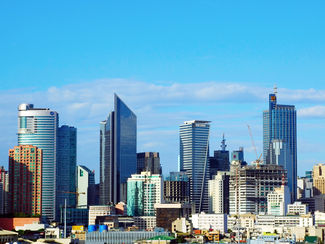 Metro Manila 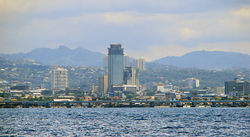 Cebu City |
||
| 1 | Quezon City | 2,679,450 | 2.53% | National Capital Region | |||
| 2 | Manila | 1,660,714 | 0.03% | National Capital Region | |||
| 3 | Caloocan | 1,378,856 | 2.53% | National Capital Region | |||
| 4 | Davao City | 1,363,337 | 1.81% | Davao Region | |||
| 5 | Cebu City | 798,809 | 2.16% | Central Visayas | |||
| 6 | Zamboanga City | 774,407 | 3.54% | Zamboanga Peninsula | |||
| 7 | Antipolo | 633,971 | 5.22% | CALABARZON | |||
| 8 | Pasig | 617,301 | 2.29% | National Capital Region | |||
| 9 | Taguig | 613,343 | 4.07% | National Capital Region | |||
| 10 | Valenzuela | 568,928 | 2.23% | National Capital Region | |||
| based on the Philippines 2007 Census | |||||||
